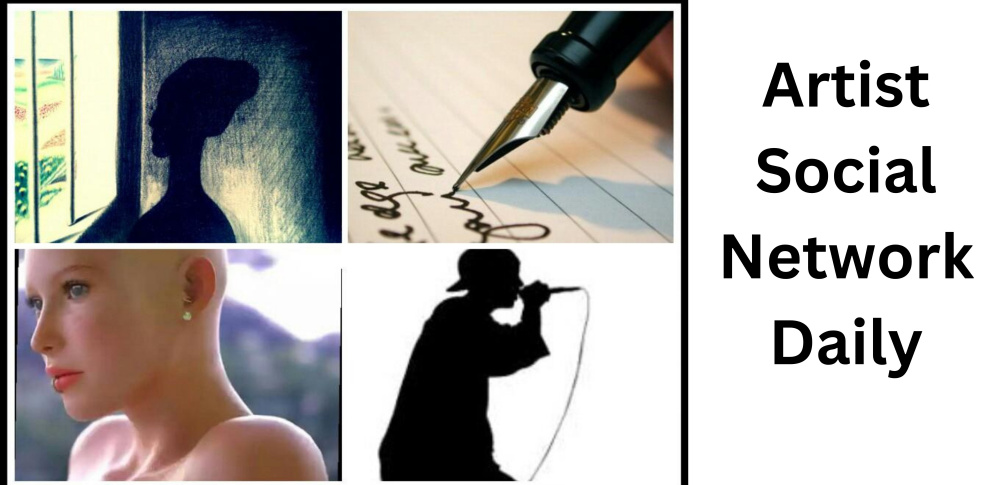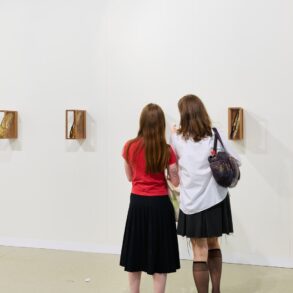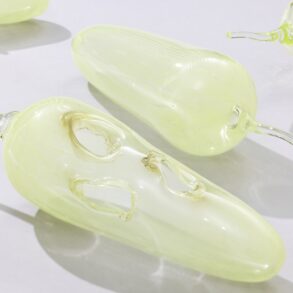
Just before releasing her highly anticipated seventh album, Lady Gaga held a secret press conference in New York City. Wearing an asymmetrical black wig, dark shades and a high-necked gothic gown, the singer swept into a room full of fans who had just heard MAYHEM for the first time.
Equal parts demure and mysterious, the 14-time GRAMMY winner sat before a table packed with microphones of all shapes and sizes, ready to take questions from some of her most devoted Little Monsters. “If MAYHEM had a character that you constructed that album for, who would it be?” one lucky fan asked early during the Q&A. And for Gaga, the answer was simple: “The lady you’ve known for the last 20 years.”
Once the rapturous cheers finally died down, the superstar went on to describe her seventh studio set as an “integration of who I am in real life and who I am on stage, and how I really started to celebrate bringing those two things together… For me, that’s my personal mayhem — otherwise known as exercises in chaos.”
The concept of multiple Gagas existing at once — that dichotomy between the onstage persona and the Italian girl from New York City named Stefani Germanotta — is further illustrated in the album’s cover art, which fittingly refracts the pop star’s pensive reflection from the fragments of a shattered mirror.
It can also be seen in the music videos for MAYHEM‘s pair of pre-release singles, the potently discordant “Disease” and the infectious, hard-charging “Abracadabra.” On the former, the artist faces off against multiple iterations of herself — one with bloodshot eyes peering out from behind an intricate leather mask, another chained to a pipe in a quiet suburban neighborhood — over a grimy, industrial beat. On the latter, which Gaga premiered during the 2025 GRAMMYs telecast, the category is “dance or die” as she inhabits dual personas clad in spiky crimson leather and a lacy white ensemble, chanting, “Abracadabra, amor-oo-na-na/ Abracadabra, morta-oo-ga-ga.”
Nearly two decades into life as pop music’s reigning queen of all things highbrow and outrageous, Gaga has referred to the new album as a return to her pop music beginnings — marking a full-circle moment for the artist who strutted onto the international stage as a fully formed superstar in the late 2000s.
Arriving fresh from the underground club circuit of New York City’s Lower East Side, Gaga made an unforgettable splash when her debut single, “Just Dance” featuring Colby O’Donis, was released in the spring of 2008. In a matter of months, the hedonistic record had become something of a sleeper hit on the charts, steadily working its way to the summit of the Billboard Hot 100 and establishing the mysterious new pop singer as a talent to watch.
By the following April, Gaga earned a second No. 1 hit thanks to her sophomore single “Poker Face,” and had properly introduced herself to the masses with her landmark debut album, The Fame. With its relentless four-on-the-floor beats and lyrics dripping with sex, glitz, sweat, and artifice, The Fame thrust certified club bangers back into pop music’s mainstream, and all over the radio — which is precisely what a young Gaga intended.
“In America, electro-pop is dirty underground music,” she mused to U.K. outlet The Guardian by the time she had topped the charts on both sides of the Atlantic. “But I am taking it to another level.”
The nascent pop sensation, who had taken her stage name from the 1984 Queen hit “Radio Ga Ga,” didn’t merely sit back and examine the concept of celebrity on her album with a cool remove. Instead, she reveled in the thrill of the chase — whether that meant likening an obsessive relationship to tabloid notoriety on fifth single “Paparazzi,” or declaring, “I can’t help myself/ I’m addicted to a life of material/ It’s some kind of joke/ I’m obsessively opposed to the typical” on the squelching title track.
On The Fame, Gaga was unapologetic about feeling destined for superstardom, and in the press, she was equally clear-eyed about the type of career she was manifesting with her smash debut.
“I don’t wanna be one song. I wanna be the next 25 years of pop music,” she boldly declared to MTV News just before releasing The Fame in 2008. “But it’s really hard to measure that kind of ambition. That kind of blonde ambition is looked at with a raised brow, because most artists don’t have longevity today, especially in fun music that’s about underwear and pornography and money.”
Naturally, both Gaga and her label, Interscope Records, wanted to strike while the iron was red-hot. And thus, The Fame Monster arrived before the end of 2009 — part celebratory reissue, part double album featuring a complete EP of eight additional songs, including gargantuan power ballad “Speechless,” the swinging crunch of “Teeth,” and an addictive little ditty by the name of “Bad Romance.”
The Fame Monster served as much more than a victory lap for the newly crowned superstar; the new tracks added an undercurrent of shadowy yin to the frothy yang of The Fame. The quartet of singles released from the new EP also continued Gaga’s domination on the charts. “Bad Romance,” legendary Beyoncé collab “Telephone” and Latin pop earworm “Alejandro” all became Top Five hits on the Hot 100, and each came with the kind of cinematic, high-fashion music video that was key to the pop singer’s guiding strategy behind her artistry.
“What has been lost in pop music these days is the combination of the visual and the imagery of the artist, along with the music — and both are just as important,” she told MTV News. “I hope [people] will take notice of the interactive, multimedia nature of what I’m trying to do…with my music, it’s a party, it’s a lifestyle, and it’s about making the lifestyle the forefront of the music.”
For her full-length follow-up to The Fame, Gaga raised her sights from hitting the dance floor to the greater mission of championing equality. Embracing her newfound role as a culture-defining pop star, Mother Monster kicked off her sophomore album with her very own freedom song titled “Born This Way.”
Infused with strains of ’90s house music, the socially conscious anthem — which cemented the singer’s status as pop royalty when it became her first single to debut at the top of the Hot 100 in early 2011 — was an inspiring, “paws up” manifesto with a powerful message dedicated to Gaga’s massive LGBTQIA+ fan base: “I’m beautiful in my way/ ‘Cause God makes no mistakes/ I’m on the right track, baby/ I was born this way.”
“I swear to you that I’m in a place right now writing music where there’s this urgency to protect and take care of my fans,” Gaga said in a 2010 cover story for Rolling Stone. “I love what they stand for. I love who they are. They inspire me to be more confident every day… And they inspire me to keep going.”
The rest of the album — also titled Born This Way — only deepened the singer’s high-minded message when it arrived in May 2011 on the heels of follow-up singles “Judas” and “The Edge of Glory.”
Speaking to LGBTQIA+ outlet OutFront Magazine, she explained that her vision for Born This Way was “inspired by the spirit of the fans, the spirit of the show and the spirit of people all over the world every night talking to me about social justice…and me realizing that my mission with music was driven in a very specific way to this point. So social justice has to be the most paramount issue that I address on the album.”
In addition to giving her beloved Little Monsters a project supercharged with acceptance, empowerment and a sense of community, Born This Way pushed the hitmaker’s sound into exciting new territories. She ventured beyond the dance-ready electro-pop that made her famous into realms of stomping country rock (fourth single “Yoü and I,” which introduced now-classic personas Jo Calderone and Yüyi the Mermaid in its epic music video), glam metal (fan-favorite deep cut “Electric Chapel”) and even offbeat techno tinged with mariachi (“Americano”).
The studio set also included perhaps the most personal song in Gaga’s oeuvre up to that point, thanks to album opener and fifth radio single “Marry The Night” and its deeply autobiographical music video, which remains a favorite among many of her most diehard fans to this day.
What’s a superstar to do after seemingly reaching the apex of cultural power and influence in just two albums? Indulge the most avant-garde, off-kilter ideas in her musical psyche, of course. For 2013’s Artpop, an album she would later refer to as her “EDM opus,” Gaga set her ambitions on another goal of ostentatious proportions: this time, to meld the elite worlds of fine and visual art with pop culture.
“Pop culture was in art, now art’s in pop culture in me,” she declared with flamboyant pizazz on lead single “Applause.” On the serene title track, she cryptically explained, “My Artpop could mean anything.”
Gaga’s meta commentary on the power of celebrity and art as cultural currency extended beyond Artpop‘s sometimes opaque lyricism. She commissioned pop artist Jeff Koons to create the album’s sculptural cover art depicting her nude form straddling a translucent blue gazing ball, and cast Andy Cohen, the Real Housewives of Beverly Hills and YouTuber SkyDoesMinecraft in the high-concept “Artpop Film” for third single “G.U.Y.,” which was filmed in part at the historic Hearst Castle in San Simeon, California. Gaga even created an entire auxiliary social media app that would bring “ARTculture into POP in a reverse Warholian expedition” and explore “Gaga’s existence as a cultural interface” in conversation with the album.
However, even after debuting at No. 1 on the Billboard 200 and becoming one of the highest-selling albums of the year with a reported 258,000 copies sold in its first week, Artpop failed to reach the commercial and critical heights of its predecessors. During its roll-out, Gaga had even teased the possibility of Artpop (Act II), a sequel album that would feature even more out-of-the-box songs than sonic experiments like “Aura” and “MANiCURE,” but the project never materialized and has since reached mythic status among the fandom.
Speaking to Harper’s Bazaar nearly six months after Artpop‘s release, Gaga acknowledged that some people simply didn’t get the album or her artistic vision for it. “Whether critics realize it or not, they’ve been in a very long argument since my public birth,” she said. “‘Is it right or is it wrong?’ This was the intention of those twisted nursery rhyme, I-aim-to-confuse-you verses in my song ‘Applause.’
“The conversation is still happening because they don’t know what to think. They’re still scratching their heads,” the star continued. “This grappling is my art form — and it’s powerful, because whether they like it or not, they’re still talking.”
Though #JusticeforArtpop would eventually become a passionate refrain among her most loyal Little Monsters in the years that followed, Gaga also admitted that the initial reception to her third album took a devastating toll on her mental health and self-confidence. “I became very depressed at the end of 2013,” she told the magazine. “I was exhausted fighting people off. I couldn’t even feel my own heartbeat. I was angry, cynical and had this deep sadness like an anchor dragging everywhere I go.”
Soon enough, however, Gaga would pull her out of her spiral with help from a dear friend: none other than Tony Bennett. The treasured crooner had tapped the younger star during the Born This Way era to duet on “The Lady Is A Tramp” for his 2011 album Duets: The Great Performances, and after Artpop, the pair teamed up once again for their joint 2014 LP Cheek to Cheek.
Featuring faithfully jazzy covers of American Songbook standards like “Anything Goes,” “I Can’t Give You Anything But Love” and “It Don’t Mean a Thing (If It Ain’t Got That Swing),” the album showed off Gaga’s sparkling chemistry with Bennett and earned the pair a GRAMMY for Best Traditional Pop Vocal Album. Around the same time, Gaga showed off her acting bonafides with a starring role as The Countess on “American Horror Story: Hotel,” which would win the multi-hyphenate her first Golden Globe, for Best Actress — Miniseries or Television Film.
Read More: Run The World: How Lady Gaga Changed The Music Industry With Dance-Pop & Unapologetic Feminism
By 2016, Gaga was ready to return to her first love, and this time she had an even more personal story to tell through the music. For her fourth solo album, the New York City native found inspiration in the life of Joanne Stefani Germanotta, her father’s elder sister who had passed away at the age of 19 due to complications from lupus.
Though the singer never met her aunt (and namesake), Joanne’s legacy loomed large in her family’s memory and identity. “I had to write about Joanne,” Gaga told Apple Music’s Zane Lowe, “because it’s the single most important event in my family’s life, and it’s the thing that has made me who I am today.”
To hone in on the sound of the reverently titled Joanne, Gaga recruited Mark Ronson and BloodPop to help helm the album’s production, stripped her songwriting of pretense and made a conscious return to the passion she’d discovered for music as a child. The result became a body of work built on a foundation of Americana style, soft rock guitars and pure, country storytelling — complete with the baby pink cowboy hat that became an indelibly tied to her image during the era.
Ballads like “Million Reasons” and the angelic title track laid out Gaga’s songwriting at its most raw and vulnerable. But that’s not to say Joanne was necessarily an acoustic album by nature. Lead single “Perfect Illusion” was a head-banging, shapeshifting tour de force, while highlights like “John Wayne” and “Diamond Heart” were, at turns, wildly rabid and joyfully festival-ready in their production and delivery. As a whole, Joanne showed the world an entirely new, intensely intimate side to a superstar who’d initially built her persona on the shock value of meat dresses and daring hooks about taking “a ride on your disco stick.”
“I think the sentiments and the stories in the album don’t have any makeup on — there’s no filter,” she added in her Apple Music sit-down ahead of Joanne‘s release. “This record goes right for the gut. And vocally, lyrically, I am trying to tap into vibrations that make you feel like I’m giving you a giant hug in a way, or giving you a release. A place to rage. Or to feel healed. To close your eyes and listen.”
To immortalize Joanne‘s creation, the singer also let cameras into her life for the 2017 Netflix documentary Gaga: Five Foot Two, which captured not only the recording process behind the LP, but also Gaga’s preparations to headline the Super Bowl LI halftime show in February 2017.
In addition, the film gave Little Monsters profound insight into Gaga’s evolution over the years, whether she was reflecting on her early days in the spotlight (“If I’m gonna be sexy on the VMAs and sing about the paparazzi, I’m gonna do it while I’m bleeding to death and reminding you of what fame did to Marilyn Monroe”); bouncing back from professional low points (“If you look at me during Artpop, and then now, I think I’m doing better. I’m just a woman struggling now instead of a girl”); or vowing to take ownership of her career like she never had before (“I want to become a woman in this business and grow up”).
Joanne also served as a natural step towards the next major high point in Gaga’s career: starring in the 2018 remake of A Star Is Born. Playing fictional singer Ally Campana opposite Bradley Cooper‘s Jackson Maine, the real-life pop star blew audiences away on songs like GRAMMY-winning centerpiece “Shallow” and Song Of The Year-nominated “Always Remember Us This Way,” and she became the first woman to win an Academy Award, BAFTA, Golden Globe, and GRAMMY in a single year during the 2019 awards season.
Following her award-winning turn on the silver screen, Gaga was finally ready to return to the studio — and the dance floor — for 2020’s colorful and connective Chromatica.
Released in the early days of the COVID-19 pandemic, the singer’s fifth solo effort was a vital light in the darkness for Little Monsters around the globe. Lead single “Stupid Love” turned into a much-needed rallying cry for kindness and compassion for a world in crisis and sophomore single “Rain On Me” with Ariana Grande became Gaga’s fifth career No. 1 hit on the Hot 100.
Although fans weren’t able to gather or experience the album’s unveiling communally, Chromatica became a clubby, house music-soaked state of mind. The LP managed to unite listeners online despite the isolation, uncertainty and fear that gripped the globe at the time — and, in turn, became her fourth consecutive album to bow atop the Billboard 200.
Presented in an orchestral, three-act structure, Chromatica also gave Gaga space and freedom to address a number of traumas, mental health struggles and personal demons that had grown into paralyzing obstacles in the years since Joanne.
“Honestly, I just totally gave up on myself. I hated being famous, I hated being a star. I felt exhausted and used up,” she admitted in a masked and socially distanced sit-down for CBS Sunday Morning in September 2020. ‘My biggest enemy is Lady Gaga,’ that’s what I was thinking: ‘My biggest enemy is her.'”
That internal war was on display most clearly on third single “911,” on which Gaga robotically sings, “Turning up emotional faders/ Keep repeating self-hating phrases/ I have heard enough of these voices/ Almost like I have no choice.”
But adopting a new, neon pink cyberpunk persona, the superstar found catharsis by immersing herself in the rhythms and attitudes of ’90s house music. “You could physically see dance music healing this person in real time, so it just became obvious very quickly that that’s what we had to do,” returning producer BloodPop toldRolling Stone of working on the project.
“I don’t hate Lady Gaga anymore,” Mother Monster was, thankfully, happy to report to CBS Sunday Morning. “I found a way to love myself again, even when I thought that was never gonna happen.” And ever conscious of using her music to lift and empower her fans, she wanted Chromatica to offer that same gift to everyone listening.
While the next four years would see fans eagerly clamoring for LG7 amid their queen’s various acting and musical endeavors — including another GRAMMY-winning album, a tenth anniversary re-release of Born This Way and another turn on the big screen in Joker: Folie à Deux — the time between Chromatica and its long-awaited follow-up would ultimately help Gaga along her journey of healing and self-love.
As a result, MAYHEM feels like an altogether different kind of gift that Gaga has given to both her Little Monsters and to herself. Each of the album’s 14 tracks represents a different shard of the shattered mirror portrayed on the cover — and only by looking into that artfully assembled reflection can Gaga fully connect every chapter of her past to the artist she is today.
A clear example: whereas an untested Gaga wantonly aspired to fame on her debut, MAYHEM-era Gaga uses knockout album cut “Perfect Celebrity” to illuminate the consequences of seeing that wish fulfilled from the other side of the looking glass. “You love to hate me/ I’m the perfect celebrity,” she wails with teeth bared on the chorus, before sneaking in a cunning reference to the album that started it all: “Choke on the fame and hope it gets you high/ Sit in the front row, watch the princess die.”
Elsewhere, the singer puts the blatant misogyny and sexism she’s experienced throughout her trailblazing career on blast on “Shadow of a Man,” an overt Michael Jackson homage she first teased during The Chromatica Ball.
More than anything, though, Gaga simply sounds like she’s having a blast across MAYHEM‘s 53-minute runtime. The irresistible, electric current coursing through “Abracadabra” pulses through the entirety of the album, whether she’s getting funky with Gesaffelstein on “Killah,” paying tribute to her late “Born This Way” video costar Rick Genest over the delirious disco delights of “Zombieboy,” or effortlessly playing the bad girl who makes the good boys bleed on the dreamy “How Bad Do U Want Me.”
Shades of the other albums in her catalog are present as well: the vibrant techno-tinged soundscape of “Garden of Eden” resurrecting the spirit of fearless experimentation Gaga blazed on Artpop; the intimate balladry demonstrated so purposefully on Joanne can be felt just under the surface of “Blade Of Grass,” a heartfelt glimpse at her relationship with fiancé Michael Polansky (who’s listed as an executive producer and co-writer of seven songs alongside Gaga in the credits).
By the time MAYHEM ends with her GRAMMY-winning Bruno Mars duet, “Die With A Smile,” it’s clear that the singer’s “exercises in chaos” have actually created a beautiful, dark, kaleidoscopic dreamscape of music — one that was only possible by bringing every part of her artistry, and every iteration of Gaga, to the table.
“I did not realize how afraid I was to make this record,” the singer confessed just days before MAYHEM‘s unveiling at the launch of Gaga Radio on SiriusXM. “I think I thought I didn’t have it in me, or that the kind of music I started making earlier in my career was something that I’d left behind.
“But,” she concluded, “I realize that all of that stuff is still in me. And it will never not be because… that music made me who I am.”
Explore The World Of Lady Gaga
This post was originally published on this site be sure to check out more of their content







